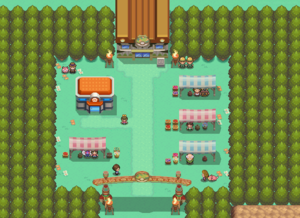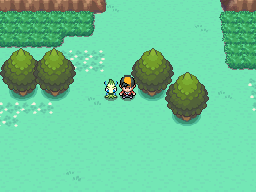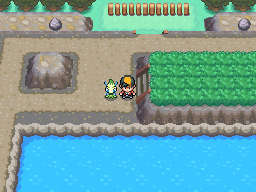GuideScroll
The Internet’s Best Game Guides

PokeMMO Safari Zone Guide
PokeMMO Safari Zone Guide by Cubes
TL;DR – For rare pokemon in the Safari Zone, the best strategy is to use 1 Bait and then throw a lot of balls. If the Pokemon stops eating and is watching carefully, throw 1 more bait then keep throwing balls. If you have 1-3 balls left, you should just throw balls without bait.
Best place to catch: Chansey- Surf across water in the entrance, go to north area. Scyther/Pinsir- Entrance Kangaskhan- Go right from entrance Tauros- Surf across water in the entrance, go to west area. Dratini/Dragonair (The catch rate is the same)- Super Rod at any body of water
Using Repels – Using a level 26 pokemon with repels will not let you encounter Chansey per se, but it will let you avoid a bunch of pokemon in-between. It’s a good time saver, if you don’t want to spend the time running away from pokemon, but you won’t catch Chansey any faster step-wise. (Credits to heated, reazh, and darkside)
Edit: added what to do in case Pokemon stops eating; added best places to catch pokemon; added what to do in case of 1-3 balls left; added repels.
Ok, so I was going through safari zone trying to catch rare Pokemon, wondering “What’s the best strategy?”. Googling gave me no answers, so I dug a little deeper. All formulas can be sourced to Bulbapedia.
A little background: every pokemon has it’s own catch rate, which determines how easy or hard it is to catch. Legendaries are hard, while Pidgey is a breeze. For every pokemon, you determine a modified catch rate (using catch rate, health, status, etc), and with this you can determine the probability of catching said pokemon. The key to remember- the higher the catch rate, the higher the probability of catching the pokemon.
Normally, if the Safari Zone was just a regular wild zone, the following would apply: all pokemon are at full health, with no status conditions.For a pokemon at full health, no status, the “modified catch rate” is 1/3(catch rate).
Let’s take for example, Chansey, of course. Chansey has a catch rate of 30. Normally, the modified catch rate is 1/3(30)x1.5 = 15. (Why x1.5? This factors in the safari ball properly, which is x1.5 the Pokeball.)
But, the safari zone is tricky, and adds in more factors! The catch rate is multiplied by 100/1275, and then rounded down, to get a “safari-catch factor”. Here is where the safari zone screws you! Doing the math for Chansey,the rounding down gives you a safari-catch factor of just 2. Normally, when you throw the ball, it multiplies back by 1275/100, then rounds down, giving you a catch rate of just 25. Fuck that noise! Screw you safari zone.
Plugging in this new catch rate into our formula, we get 1/3(25)x1.5 = 12.5. But we have to round down (again), so it’s actually 12.
Now we have a safari-modified catch rate for Chansey, 12. Using Bulbapedia’s formula, we have a probability of approximately 4.7% of catching Chansey per ball thrown.
“But Cubes,” you ask, “what about bait and rocks? How do those affect things?”
Very interestingly, in fact. What happens is that rocks double the safari-zone factor and bait halves it. Taking Chansey as an example for all the rare pokemon, with bait, her safari-catch factor is a measly 1, and we get a catch rate of just 12, and a modified catch rate of just 6. Your odds of catching Chansey are 2.4% per ball thrown.
As for rocks, a sneaky cool thing happens for Chansey. The safari-catch factor doubles, becoming 4, and then when you multiply by 1275/100, we get a catch rate of 51, and a modified catch rate of 25.
Did you see what happened? It’s slightly more than double the regular modified catch rate, and this affects things. The odds of catching Chansey becomes 9.8% per ball thrown with the rock effect.
Now you must be thinking, rocks all the way! But, we’ve forgotten about escapes, and this is where the rock fails us. (Now unfortunately, I couldn’t find escape rates for the pokemon, but it shouldn’t affect the outcome.) When angry, a pokemon is twice as likely to escape. But when busy eating, the pokemon is 1/4 less likely to escape, a big difference.
So, you see that you get 4 bait balls every time you throw 1 rock ball, and when you add up the percentages, you get 9.8% rock vs. 9.6% bait, and . But we also have to take into account the first turn. The pokemon is angry/eating after the first turn, and so you are ~7-8 times as likely to be able to throw your first bait ball before even throwing your first rock ball, and this tilts the favor in the bait’s favor.
How the escape factor works is that the escape rate(which is an integer) is multiplied by 5, and then affected by rock/bait to get a final rate. Then a random number between 0-99 is generated. If this number is lower than the final rate, the pokemon escape. For a rare pokemon, the rate is either 8 or 9 (I’m not sure), but let’s say 9. Then the normal final rate is 45, and there’s a 55% chance your pokemon will stay per turn. While angry, the rate becomes 90, and you only have a 10% chance of the Pokemon staying. While eating, the rate becomes 11 (rounded down), and you have an 89% chance of the pokemon staying per turn.
Factoring this in, you get- an 11% chance to be able to throw rock and 1 ball consecutively- 1.15% chance of capture; a 55% chance to be able to throw 2 regular balls consecutively- 7.29% chance of capture; a 50% chance to be able to throw bait and 3 balls, followed by a bait and 2 more balls consecutively- 8.26% chance of capture.
So as you can see, rock is a TERRIBLE strategy, and bait better than just throwing balls. I can explain the math I did behind this if anyone wants me to.
How many baits should you use? Just 1. When using multiple baits, the effect on the safari-capture factor stacks, but the escape factor does not. In short, each additional bait halves your catch chance while doing nothing to the escape chance.
Another factor in bait’s favor- the Safari Zone restrictions. You only get 30 balls and 500 steps. But Chansey (and other rare Pokemon) are so rare that your steps will run out before your balls do. So a strategy that maximizes the amount of balls thrown per catch attempt is the most efficient use of your hard-earned 500 Pokedollars. This doesn’t apply when catching dratini/dragonair though, since you can stay still the whole time.
Related Articles
Pokemmo speed tier lv50 ou/uu guide.
October 23, 2013
PokeMMO Training Moves Team Building and Tactics
Pokemmo island four and sapphire guide.
October 20, 2013
- Pingbacks 0
You can circumvent the step limit by standing in a patch of grass and turning in circles without moving to a different tile.
Leave a Reply
Your email address will not be published. Required fields are marked *

Recent Comments
- Yustar on Wizard101 Myth Minions Guide
- Zoeypeeba on Eden Eternal Shaman Guide
- Unone on Pockie Ninja Suit Stats Guide
- ? on Monster Legends Breeding Times
- Anonymous on Mortal Online 2 Book Locations Guide
10564297 front page hits
The Cave of Dragonflies
Where the smallest bugs live alongside the strongest dragons
R/B/Y Safari Zone Mechanics
A staple of the Pokémon series since the originals is the Safari Zone: a special place with Pokémon that aren't found anywhere else (and some that are) where instead of getting to use your own Pokémon to weaken and capture them, you must employ more old-fashioned methods while the Pokémon may run at any moment. While they haven't been in every game, they shake up the usual routine of catching Pokémon and have had various interesting mechanics through the generations - however, the very most interesting has to be the original.
How It Works
In every Safari Zone, the player is unable to use their own Pokémon at all. Instead, when you encounter a Pokémon you have four options: throwing one of the limited number of Safari Balls you have; an aggressive action used to make the Pokémon easier to catch; an enticing action used to make it less likely to run away; or running away from the battle yourself.
In Red, Blue and Yellow, the aggressive action is called Rock , and the enticing action is called Bait . The basic idea is this: throwing a rock will double your chances of catching the Pokémon, but it will also make the Pokémon angry for 1-5 turns. Conversely, throwing bait will halve your chances of catching the Pokémon, but cause the Pokémon to be eating for 1-5 turns. While angry, a Pokémon is twice as likely to run on any given turn as if it were in its neutral state, while it is four times less likely to run while it is eating than in a neutral state.
However, there are several more interesting details and subtleties to how Safari Zone battles happen.
Throwing a Ball
Capturing in the Safari Zone follows the regular R/B/Y capture algorithm , though since neither the Pokémon's HP nor its status can be affected and the only balls available are Safari Balls (identical to Ultra Balls), a lot of things are abstracted out in the Safari Zone. Unfortunately, thanks to the game's flawed RNG , Safari Balls underperform against full-health Pokémon, making all capture chances in the Safari Zone lower than intended. The capture chance maxes out when the Pokémon has a catch rate of 150 or more, for which the chance will be about 27-30% depending on rounding errors; all other Pokémon are harder than that.
The catch rate C starts out being, as in regular captures, the intrinsic catch rate of the Pokémon species. However, unlike regular captures, your actions in the Safari Zone can directly modify C, as hinted above.
Throwing Rocks/Bait
Rocks and bait have two distinct effects. First, every time a rock is thrown, the catch rate C is doubled (though it is capped at 255, so if doubling would make the catch rate more than that, it is made 255 instead), and every time bait is thrown, C is halved and rounded down. This happens even if the Pokémon is already angry or eating, and it happens completely blindly - if the Pokémon has a catch rate of 235, and you throw a rock to give it a catch rate of 255, then throwing bait will take that catch rate down to 127, rather than "canceling out" to give it the same catch rate as before.
Since the capture chance maxes out when the catch rate is 150 as explained above, there is no point throwing rocks at any Pokémon with an intrinsic catch rate of 150 or more, or more than one rock at a Pokémon with a catch rate of 75 or more, or more than two rocks at one with a catch rate of 38 or more. As it happens that covers all Pokémon that can be found in the Safari Zone except for Chansey (catch rate 30) and Dragonair (catch rate 27 in Yellow), who would need three rocks to go over 150.
Secondly, while a battle in the Safari Zone is going on, the game also keeps track of two counters, the "angry counter" and the "eating counter", which stand for the number of angry or eating turns the Pokémon has left. They both start out at zero; however, when a rock or bait is thrown, a random number between 1 and 5 inclusive will be generated and added to the appropriate counter (i.e. the angry counter if it's a rock, or the eating counter if it's bait), while the other counter will be reset to zero regardless of its previous value. This means only one of the counters can be nonzero at any given time. Since the random number is added to whatever value the counter already has, throwing further rocks at a Pokémon that is already angry will prolong its angry state, and likewise with throwing bait at an eating Pokémon. The eating and angry counters are both capped at 255.
The Pokémon's Turn
You always get the first turn in the Safari Zone, but on the Pokémon's turn, two things happen.
First, the game will check if either of the angry and eating counters is nonzero. If so, then a message saying "Wild [Pokémon] is angry!" or "Wild [Pokémon] is eating!" as appropriate is shown and the counter is decreased by one. If the angry counter is decreased to zero this way, the Pokémon's catch rate will also be reset to its initial catch rate , regardless of how it has been modified in the battle before this point; note that this last bit does not happen when a Pokémon stops eating, nor when the angry counter is reset to zero because you threw a bait.
After this, the game will perform a calculation to determine whether the Pokémon will run away on this turn. The run chance depends only on which state the Pokémon is in - angry, eating or neutral - but not on how many times you've thrown rocks/bait in any way: a Pokémon that you've thrown five rocks at followed by one bait will be exactly as happy to stick around as one that you threw a bait at on the first turn. Note that the Pokémon's actual current state does not necessarily correspond to the state indicated by the message that was just shown, since the message indicates only that the counter in question was nonzero before it was subtracted from. This also means that if you throw a rock or bait and the random number generated is 1, you will see an angry/eating message, but the Pokémon will in fact be back in its neutral state before even the run check is performed.
The run calculation itself goes as follows:
- Make a variable X equal to the low byte (i.e. the remainder if you divide by 256) of the Pokémon's Speed ( not the base Speed of the species, but the individual's actual Speed).
- If the outcome is greater than 255 (i.e. if the Pokémon's Speed was 128 or more), the Pokémon automatically runs. Skip the rest of the procedure.
- If the Pokémon is angry, double X again (if it becomes greater than 255, make it 255 instead).
- If the Pokémon is eating, divide X by four.
- Generate a random number R between 0 and 255 inclusive.
- If R is less than X, the Pokémon runs away.
All in all, this means that so long as (the low byte of) the Pokémon's Speed is less than 128 (which it always will be in the actual game - the highest Speed any Pokémon actually found in the Safari Zone can have is 75), the chance that it will run is 2*Speed/256 if it's in a neutral state, min(255, 4*Speed)/256 if it's angry, or int(Speed/2)/256 if it's eating.
Crucially, since this is the actual individual Speed and not the base Speed of the species, lower-leveled individuals are less likely to run . While Scyther at level 25 or 28 have around or above a 50% chance of running every turn in a neutral state, for instance, Yellow's level 15 Scyther are considerably easier to catch, with only a 32% chance of running in a neutral state at the most. Thus, perhaps the best piece of strategic advice for the Safari Zone is to go for the lowest-leveled possible version of your desired Pokémon, given the lower-leveled version isn't unacceptably rare.
So, well, how should one go about trying to achieve success in the Safari Zone, other than trying to catch lower-leveled Pokémon? Four basic kinds of strategies come to mind:
- Balls only. This is the simplest way to go about the Safari Zone - just madly lob balls at everything you want to catch and pray that they don't run before you catch them.
- Rocks, then balls. Throw some sensible number of rocks, then lob balls and hope you catch it before it either runs or calms down and resets the catch rate. If you see it's not angry anymore, start again from scratch with the rocks.
- Bait, then balls. Throw some bait to put the Pokémon in the eating state and make it stick around, then throw balls and hope the reduced catch rate doesn't come back to bite you. Unlike with rocks, where once the Pokémon stops being angry you're back at square one, it's not quite as obvious here that you should throw more bait once the Pokémon stops eating - each bait you throw lowers the catch rate more, after all.
- Rocks to increase catch rate, then bait to get it to stay, then balls. Throw a rock or two (or three) and then immediately throw bait. Provided your first rock doesn't generate one as the number of angry turns (in which case the Pokémon will calm down immediately and reset the catch rate), you'll manage to increase the Pokémon's catch rate before the bait gets thrown, meaning you end up with a catch rate of the same, double or quadruple the original (depending on the number of rocks), but a 4x reduced chance of running and assurance that the catch rate won't reset when it returns to the neutral state.
There are other possible strategies, but they appear obviously flawed - if you were to throw bait and then a rock, for instance, you'd end up with a normal catch rate but a higher running chance after wasting two turns, which can't possibly be helpful. These are the main ones that at a glance appear to hold some kind of promise.
You may think, as I did when I was initially working this out, that the fourth strategy has the most potential. However, as it turns out, the R/B/Y Safari Zone is broken: the balls-only strategy nearly always wins by a considerable margin, at least in terms of your overall chance of catching the Pokémon per encounter. Wasting your time on bait and rocks is only worth it in a couple of very exceptional cases.
Wait, What?
Good question. If you don't care about getting an intuitive grasp on why this is true, feel free to skip to the Safari Zone calculator.
Here's the thing. The entire Safari Zone experience basically simplifies to a game where you and the Pokémon alternate turns, with each of you having a given chance of "winning" on each of your turns (you win if you catch the Pokémon, while the Pokémon wins if it runs). When you throw bait or a rock, however, you do that instead of throwing a ball on that turn, while the Pokémon will continue to have a chance of running on every single one of its turns; essentially, you are forgoing one of your turns (attempts to "win") in exchange for a later advantage.
What is that later advantage, then, and is it worth losing that turn? Well, in the case of a rock, you double your chances of winning (catching the Pokémon) for up to four subsequent turns - but you also double the Pokémon's chances of winning (running away), and because you used up your turn throwing the rock, it's the Pokémon that has the next move.
You can hopefully see how that's not really a recipe for success. However, it's not quite as bleak as it appears, thanks to the one place where the simplification breaks down: you have a limited number of Safari Balls. A rock, by doubling both yours and the Pokémon's chances of winning each turn, will shorten the average duration of the battle. Thus, if you have sufficiently few balls and the Pokémon has a sufficiently low catch rate and Speed, to the point that in an average battle against it you'd run out of balls before either catching it or it running, throwing a rock and shortening the battle so your balls will last can actually be worth it, even at the aforementioned cost. For instance, if you only have one Safari Ball left, then you can either throw that one ball with a regular catch rate or throw some rocks first, which will make your single ball much more likely to be effective once you do throw it; you'll only get one attempt to catch it either way. The risks will still outweigh the benefits if the Pokémon is pretty speedy, since then it will be likely to run before you can actually throw the ball at all, but for a sufficiently slow target (for a single Safari Ball, the highest Speed where a rock will be worth it is 25 or so), rocks can be a good idea when you don't have a lot of Safari Balls left.
Throwing multiple rocks can also help, at least in theory, since more rocks will continue to double your chances of catching the Pokémon without raising the running chance further. Primarily, in many of those situations where a lack of Safari Balls means one rock is a good idea, two (or possibly three) rocks improve your chances even further, though the range of situations where this works is even narrower than for one rock. Technically multiple rocks can also help in general for Pokémon with very low Speeds and low catch rates - however, that's low Speeds as in single digits, and no Pokémon that fit the bill are actually found in the Safari Zone, making that point kind of moot. Otherwise, if you have plenty of balls to spare, the free angry turns they usually get to run away before you even start trying to catch them just result in a disadvantage you can't make up for.
What about bait? Bait is immediately somewhat more promising than rocks, since it halves your chance of "winning" but quarters the Pokémon's. However, bait also differs from rocks in that the catch rate doesn't go back to normal after the Pokémon stops eating, and just like rocks shorten the duration of the battle, bait prolongs the battle - it makes both parties less likely to win on subsequent turns. And the longer the battle goes on, the more the up-to-four turns (remember, the counter is decreased before the run check) that the Pokémon is actually less likely to run diminish in significance compared to all the turns after the Pokémon stops eating, when it will still have a lowered catch rate but a regular chance of running. That's besides the fact that again you must forgo a turn to throw the bait in the first place. In fact, as it turns out this makes bait wholly useless: there is not even in theory a Speed/catch rate combination for which bait will do you any good.
Where does this leave that especially promising-looking "rocks, then bait" strategy? Ultimately, it's stuck in the same rut rocks are: it's normally only useful for Pokémon with such ludicrously low Speed that they don't actually exist in the Safari Zone, and unfortunately, while rocks at least have a niche when you're running low on balls, you're always going to be better off just throwing however many rocks you're going to throw and then throwing your ball than throwing the rocks and then wasting your time on bait if you only have a couple of balls left. This strategy requires wasting several turns without throwing any balls, during some of which the Pokémon will have an increased chance of running, and to make matters worse, if the number of angry turns generated is one, you're going to lose even the rock's advantage and end up with the bait's lowered catch rate after all that preparation. It just kills it.
So, again, in nearly every case the best strategy is to just throw balls and hope you get lucky. That is, however, assuming that what you want to maximize is your chance of success per encounter: since rocks shorten the battle and make for fewer Safari Balls required, rocks may actually save you time and money.
The Safari Zone calculator below includes a variety of strategies, despite their mostly limited usefulness; play around with it if you think you might go with a different one.
Safari Zone Calculator
Use this tool to calculate your chances of capturing a given Pokémon.
As it is, it only includes Pokémon that are actually found in the Safari Zone in either Red, Blue, Yellow, or the Japanese-exclusive Blue version. If there is demand for adding other Pokémon just for the hell of it, I can do that too, but in the meantime, I feel this makes more sense.
In addition to your chances of capturing the Pokémon with any or all of the provided strategies, the calculator will also provide you with the basic capture rate and run chance per turn. When you select a Pokémon and game, additionally, it will give you the locations, levels and rarities at which the Pokémon is found in the Safari Zone in that game, so that you can perhaps attempt to find your Pokémon at a lower level or in an area where it's more common.
The base percentages the calculator gives may not match exactly up with those given by my R/B/Y catch rate calculator , since this calculator makes the simplifying assumption that the Pokémon's HP and Speed are equal to the average HP/Speed a wild Pokémon of the given species/level would have, while the catch rate calculator does the entire calculation for each possible HP IV and takes the average of the actual outcomes. I chose not to do the more accurate calculation here because this calculation is both already relatively slow and involves two different stats - trying every possibility would mean doing that whole relatively slow calculation up to 256 times, which just seems like way more trouble than it's worth.
Pokémon: Chansey Cubone Doduo Dragonair Dratini Exeggcute Goldeen Kangaskhan Krabby Lickitung Magikarp Marowak Nidoran (f) Nidoran (m) Nidorina Nidorino Paras Parasect Pinsir Poliwag Psyduck Rhyhorn Scyther Slowpoke Tangela Tauros Venomoth Venonat
Game: Red Blue/JP Green JP Blue Yellow
Safari Balls remaining:
Strategy: Show all Balls only One rock Two rocks Three rocks Bait repeatedly One bait Two bait Three bait Rock, then bait Two rocks, then bait Three rocks, then bait
Page last modified August 9 2021 at 02:53 UTC
- PRO Courses Guides New Tech Help Pro Expert Videos About wikiHow Pro Upgrade Sign In
- EDIT Edit this Article
- EXPLORE Tech Help Pro About Us Random Article Quizzes Request a New Article Community Dashboard This Or That Game Popular Categories Arts and Entertainment Artwork Books Movies Computers and Electronics Computers Phone Skills Technology Hacks Health Men's Health Mental Health Women's Health Relationships Dating Love Relationship Issues Hobbies and Crafts Crafts Drawing Games Education & Communication Communication Skills Personal Development Studying Personal Care and Style Fashion Hair Care Personal Hygiene Youth Personal Care School Stuff Dating All Categories Arts and Entertainment Finance and Business Home and Garden Relationship Quizzes Cars & Other Vehicles Food and Entertaining Personal Care and Style Sports and Fitness Computers and Electronics Health Pets and Animals Travel Education & Communication Hobbies and Crafts Philosophy and Religion Work World Family Life Holidays and Traditions Relationships Youth
- Browse Articles
- Learn Something New
- Quizzes Hot
- This Or That Game
- Train Your Brain
- Explore More
- Support wikiHow
- About wikiHow
- Log in / Sign up
- Hobbies and Crafts
- Video Games
- Multi Platform Games
- Pokemon Video Games
How to Catch Pokémon in Safari Zone
Last Updated: May 21, 2023 References
This article was reviewed by Ishrak . Ishrak is a Gaming & Video Expert specializing in sharing Pokémon and Minecraft videos. With over seven years of gaming and streaming experience, Ishrak has a follower base of over 30,000 YouTube subscribers and over 8 million views. He is also a Pokémon ROM-Hacker and some of his most popular videos highlight tips and advice for people learning how to play Pokémon games. This article has been viewed 113,755 times.
In the Pokémon series of games, Safari Zones are special unique areas in each game where rare Pokémon that don't appear anywhere else in the game can be caught. Safari Zones always operate with different rules than the rest of the game world - instead of battling Pokémon in the wild like you normally would, you'll need to carefully use baits and deterrents to get Pokémon to let down their guards so you can catch them. This can be quite challenging, so knowing the ins and outs of Safari Zone mechanics in each game is vital for success.
Navigating the Safari Zone
Fighting and capturing pokémon.

- Note that the "run away" option functions as normal, so we won't be discussing it.

- However, using bait will also make the Pokémon more difficult to catch in a safari ball. Thus, striking a balance here can be difficult — the longer you get the Pokémon to stick around for, the harder it will be to actually capture it.

- However, there's an important downside: using rocks will also make the Pokémon more likely to run away. In fact, after taking more than a few rocks, a Pokémon is virtually guaranteed to run away — some will exit the battle sooner. Thus, once again, using rocks means striking a delicate balance as you try to capture your Pokémon.

- Note that you only have a limited supply of safari balls (depending on the game, usually 30), so save them for Pokémon you want to catch. It's generally the best use of your time to use your safari balls for Pokémon that are only found in the safari zone.

- Note that safari balls are weak compared to the pokéballs you can use in the rest of the game. In addition to this, especially rare Safari Zone Pokémon are extra-difficult to catch. [2] X Research source This can lead to some very frustrating situations — for instance, it can easily take 20 or more tries to catch an exceptionally rare Pokémon like Clefairy.
General Tips

- Bulbapedia, an online user-supported Pokémon encyclopedia, has extensive information about each game's Safari Zone, including maps and guides covering where to look for the Pokémon in each zone. See the Bulbapedia Safari Zone article to get started. [3] X Research source
- Note that there is no step limit in the Safari Zone in Pokémon HeartGold and SoulSilver. [4] X Research source

- Across all of the games in the series, the entrance fee has stayed the same: 500 P . This includes the Great Marsh in Pokémon Diamond/Pearl/Platinum, which is not technically a Safari Zone but behaves very similarly.
- One smart strategy is to save your game before you enter the Safari Zone. This way, if you don't catch any Pokémon you want, you can re-load to avoid paying the entrance fee again.

- As an example of the sort of equation used in the games to determine whether certain Pokémon are captured, consider the equation from the Generation games (Gold and Silver): a = max((3 × HP max - 2 × HP current ) × rate modified / (3 × HP max ), 1) + bonus status where HP max is the Pokémon's maximum HP, HP current is the Pokémon's current HP, rate modified is the catch rate of the Pokémon modified by the ball used (every Pokémon and every ball modifies this in a certain way, and bonus status is the modifier for any status condition (sleep and freeze are 10, all others are 0). [5] X Research source When you throw a ball, a random number between 0 and 255 is generated. If this number is less than or equal to a, the Pokémon is caught.
Catching Pokémon in the Kanto Safari Zone
In the following sections, we'll highlight the rare Pokémon in each Safari zone and give specific advice where applicable. To keep these tables to a reasonable size, we've included only the rarest Pokémon in each area — for exhaustive information, consult the Safari Zone guides at Serebii.net and Bulbapedia.
Catching Pokémon in the Hoenn Safari Zone
Note that the Generation 4 Hoenn Safari Zone (Omega Ruby/Alpha Sapphire) won't be covered here as the player is allowed to engage in ordinary battles in this zone.
Catching Pokémon in the Sinnoh Great Marsh
Though Sinnoh's Pokémon preserve has a different name, it functions virtually identically to Safari Zones in other regions.
Catching Pokémon in the Johto Safari Zone
Note that the Safari Zone is not available in Generation 2 (Gold/Silver) but is available in the Generation IV games that visit Johto (HeartGold/SoulSilver). Note also that in this Safari Zone the player can arrange the six different areas in any arrangement desired. Finally, many of the areas in the Johto Safari Zones have Pokémon appearance rates that are not yet known — only data for the known areas has been included. See Bulbapedia for more information. [6] X Research source
Expert Q&A
- Once again, the data in the tables above only deals with the most noteworthy Pokémon in each area. In fact, many more Pokémon appear in each Safari Zone. Thanks Helpful 3 Not Helpful 2
- Remember — you have a limited number of steps inside the Safari Zone, not a limited amount of time. Thus, you can take as long as you like if you control your movement carefully. Thanks Helpful 1 Not Helpful 3
You Might Also Like

- ↑ http://bulbapedia.bulbagarden.net/wiki/Kanto_Safari_Zone
- ↑ https://strategywiki.org/wiki/Pok%C3%A9mon_Red_and_Blue/Safari_Zone
- ↑ https://bulbapedia.bulbagarden.net/wiki/Safari_Zone
- ↑ https://bulbapedia.bulbagarden.net/wiki/Johto_Safari_Zone#Areas
- ↑ https://bulbapedia.bulbagarden.net/wiki/Catch_rate#Capture_method_.28Generation_II.29
About This Article

- Send fan mail to authors
Reader Success Stories
Jan 16, 2017
Did this article help you?

Apr 1, 2018

Featured Articles

Trending Articles

Watch Articles

- Terms of Use
- Privacy Policy
- Do Not Sell or Share My Info
- Not Selling Info
wikiHow Tech Help Pro:
Level up your tech skills and stay ahead of the curve

- Remember me Not recommended on shared computers
Forgot your password?
- General Discussion
Proof that the optimal Safari Zone strategy is to throw balls every turn

By Atricos September 11, 2021 in General Discussion
Recommended Posts


Harmonia2Side

Link to comment

On 9/15/2021 at 4:04 AM, FighterChamp said: You explained maths better than college professors
This so much. I found it hard to believe that even an anti-maths person like myself understood everything you wrote.
- FighterChamp

5 hours ago, RysPicz said: This so much. I found it hard to believe that even an anti-maths person like myself understood everything you wrote. Props!
I didn't expect many people would understand it, so thank you!
On 9/11/2021 at 11:01 PM, Kiralexis said: If they're not actually serving a purpose, why have they been here since Generation 1? Did the formulas change over the years, or is it a PokeMMO thing?
Because devs probably threw random percentage values in there and didn't bothered to see if they were even worth using to begin with I assume.
Very nice paper, are you by any chance a Uni math teacher or a thesis student ? Your paper looks very much like what we get handed for classes in here tbh

On 9/11/2021 at 11:29 PM, Paul said: dn?
deez nuts haha gottem
- 3 weeks later...

I just read your paper and, forgive me if I'm wrong, but I think there is a slight flaw in the logic with respect to its title.
The paper aims at providing the "optimal Safari Zone strategy" but what it actually does is providing the catching probability of a single Pokémon encoutered in the Safari Zone depending on the action of the player (ball, bait or rock), which is a different thing in my opinion. In my understanding, an "optimal Safari Zone strategy" should focus on optimizing the player actions to catch as many of the Pokémon you're looking for in a single Safari Zone run.
For example, let's say I want to catch a rare Safari Zone Pokémon (e.g. Tauros). I may run around for like 5 minutes and waste like 200 steps to finally get one to appear. When it does appear, your paper is probably right that my best strategy to catch this particular one Pokémon is just to throw balls at it. However, it fails to account for the cost of failure. If the Pokémon does flee, then I'm down for 5 more minutes of running around and wasting 200 more steps. I am most well served by first throwing a bait then throw balls while the Pokémon is eating (and repeat when it stops eating) because that reduces the flee rate and having the pokémon flee in this scenario is costly in terms of time and money.
The opposite example is let's say I want to catch a very common Safari Zone Pokémon (e.g. Magikarp). In this case the limiting factor of my run is the number of Safari Balls because I don't really care if the Magikarp flees as I can just fish up a new one directly. That means I am most well served by throwing a rock at it first because that means I will have to throw less Safari Balls overall, which means more Magikarps caught on a single run, thus being a more optimal run.
Because of the above, I think the flee rate should be weighted in some way by the encounter rate ( e ) to truly be an optimal strategy. I expect you would end up with a formula with c , f , and e rather than "only throw balls". To decide which is the optimal Safari Zone strategy to farm for a given Pokémon, you'd then need to enter its values for c , f and e in the formula and, depending on the result, I expect either "bait then balls" (for low encounter rates and high flee rates) or "rock then balls" (for high encounter rates and low flee rates) to be the optimal strategy.
What do you think ? To be honest, I'm too lazy (and less capable than you) to actually do the actual maths for those.
ScizoMonkey
- 8 months later...

ActualBlueBlu
this is like that one time a master of math made a entire pdf to find out if Dream cheated or not in his speedrun of minecraft i love this , great work on this research

if i understood right, if you have few balls yet and many steps, you can catch more pokemon by throwing them a rock before a ball, avoiding running out of balls;
meanwhile i would confirm the uselessness of the baits (but this would totally change if a pokemon never flees after throwing a bait, witch it never happened to me as far as i remember)

Do you know How to catch a pokemon??
By throwing a pokeball
Now you know.

On 10/7/2021 at 4:45 AM, Greymore said: Hello ! I just read your paper and, forgive me if I'm wrong, but I think there is a slight flaw in the logic with respect to its title. The paper aims at providing the "optimal Safari Zone strategy" but what it actually does is providing the catching probability of a single Pokémon encoutered in the Safari Zone depending on the action of the player (ball, bait or rock), which is a different thing in my opinion. In my understanding, an "optimal Safari Zone strategy" should focus on optimizing the player actions to catch as many of the Pokémon you're looking for in a single Safari Zone run. For example, let's say I want to catch a rare Safari Zone Pokémon (e.g. Tauros). I may run around for like 5 minutes and waste like 200 steps to finally get one to appear. When it does appear, your paper is probably right that my best strategy to catch this particular one Pokémon is just to throw balls at it. However, it fails to account for the cost of failure. If the Pokémon does flee, then I'm down for 5 more minutes of running around and wasting 200 more steps. I am most well served by first throwing a bait then throw balls while the Pokémon is eating (and repeat when it stops eating) because that reduces the flee rate and having the pokémon flee in this scenario is costly in terms of time and money. The opposite example is let's say I want to catch a very common Safari Zone Pokémon (e.g. Magikarp). In this case the limiting factor of my run is the number of Safari Balls because I don't really care if the Magikarp flees as I can just fish up a new one directly. That means I am most well served by throwing a rock at it first because that means I will have to throw less Safari Balls overall, which means more Magikarps caught on a single run, thus being a more optimal run. Because of the above, I think the flee rate should be weighted in some way by the encounter rate ( e ) to truly be an optimal strategy. I expect you would end up with a formula with c , f , and e rather than "only throw balls". To decide which is the optimal Safari Zone strategy to farm for a given Pokémon, you'd then need to enter its values for c , f and e in the formula and, depending on the result, I expect either "bait then balls" (for low encounter rates and high flee rates) or "rock then balls" (for high encounter rates and low flee rates) to be the optimal strategy. What do you think ? To be honest, I'm too lazy (and less capable than you) to actually do the actual maths for those.
I agree with you about the rocks on common Pokemons. It is the best way to not waste balls.
However for rare Pokemons I really think the ball only is way better. Because the flee rate of pokemon like Chansey, Kangaskan, Cyndaquill or Totodile is horribly high. So you just loose one turn and you usually only have one or two turns to catch them
- 1 month later...

if you have a link to the pdf or the latex source text that would be awesome!
On 10/7/2021 at 11:45 AM, Greymore said: The paper aims at providing the "optimal Safari Zone strategy" but what it actually does is providing the catching probability of a single Pokémon encoutered in the Safari Zone depending on the action of the player (ball, bait or rock), which is a different thing in my opinion. In my understanding, an "optimal Safari Zone strategy" should focus on optimizing the player actions to catch as many of the Pokémon you're looking for in a single Safari Zone run.
Yea no actually nobody really care about that aspect in reality. What people want to know is the best method to catch rare pokemon / shinies in safari. Considering Safari costs are neglectable in game. But your reasoning is fair
Create an account or sign in to comment
You need to be a member in order to leave a comment
Create an account
Sign up for a new account in our community. It's easy!
Already have an account? Sign in here.
- Existing user? Sign In
- Online Users
- All Activity
- My Activity Streams
- Unread Content
- Content I Started
- Leaderboard
- Create New...
Important Information
By using this site, you agree to our Terms of Use and Privacy Policy .

- Search forums
- Hi all. We have had reports of member's signatures being edited to include malicious content. You can rest assured this wasn't done by staff and we can find no indication that the forums themselves have been compromised. However, remember to keep your passwords secure. If you use similar logins on multiple sites, people and even bots may be able to access your account. We always recommend using unique passwords and enable two-factor authentication if possible. Make sure you are secure.
- Be sure to join the discussion on our discord at: Discord.gg/serebii
- If you're still waiting for the e-mail, be sure to check your junk/spam e-mail folders
- Pokémon Games
- Pokémon Generation III Discussion
- Ruby, Sapphire, and Emerald
safari zone tips...
- Thread starter dripdrop
- Start date Jul 6, 2006
Thunder Trainer
- Jul 6, 2006
are there any strategies for the safari zone? (other than throw safari balls) and are pokeblocks good?
Golden_Latias
#slayqueenslay.
Pokeblocks help lure more Pokemon to the area, I think. Throwing a Pokeblock when you encounter them makes them stay, I know that.
SneazzL.com
any tips on catching good pokes? i only catch weaklings also how do you make really good pokeblocks?
dripdrop said: any tips on catching good pokes? i only catch weaklings also how do you make really good pokeblocks? Click to expand...
Dark Aerodactyl
I am not a spammer.
pokeblock help you alot
Dark Aerodactyl said: pokeblock help you alot Click to expand...
Eevee_Master
I don't use them. I only use them for contests and stuff ^.^
are there any non-rsyduck pokes in the water?
mewfanforlife
Well-known member.
Pokeblocks don't help that much. I've caught all the safari Pokiemon without ever using one.
<-- Solves any case!
pokeblocks help. but only if the pokemon has the right nature. It will run less easely. It can still run however, even if the pokemon has te right nature but the chances are just smaller. Further if you're searching for a specific nature put a SINGLE flavour pokeblock in those feeders (those white blocks in the midle of the grass) and you'll get only pokemon of a nature that corrosponts with that flavour. (if you use bunnyhop on the acrobike the pokeblock stays there and you can stay as long as you desire to stay in the safari zone.) example: red for attack boosting nature. that way i caught 10 herracross with attackboosting nature.
If you are looking for a rare pokemon, go to its area an only slightly tap the D-pad, that way you will still remain in one spot, only facing a different direction, using this, won't waste the 500 steps. Also when looking for pikachu, you can use a pokemon with static to find it easier, or a pokemon with compound eyes to get a pokemon with an item. Synchronize will make it easier to catch pokemon with the same nature.
Explosion said: If you are looking for a rare pokemon, go to its area an only slightly tap the D-pad, that way you will still remain in one spot, only facing a different direction, using this, won't waste the 500 steps. Also when looking for pikachu, you can use a pokemon with static to find it easier, or a pokemon with compound eyes to get a pokemon with an item. Synchronize will make it easier to catch pokemon with the same nature. Click to expand...
you amaze me.
Either Pokeblocks or you could catch a wild Tropius or Oddish/Gloom and use it's Sweet Sent to lure pokemon to you.
pokeblocks don't lure the pokemon. they just make 5 certain natures appear. (namely the ones that like that specific flavour) for making them appear without using ACROBIKE (not pokeblocks) you could use sweetscent.
- Jul 7, 2006
ok are there any pokeblock feeders in the mach bike area?
pokeblocks do that??? i dont use them other than contests for my pokemon um to save time dont move just rotate and stuff.
Chimecho3000
milotic111 said: it's lightlingrod and not static. Click to expand...
Shiny Pokemon Chaser Ky
<-gotcha, 140 eggs.
milotic111 said: it's lightlingrod and not static. for the nature. synchronize makes it easier but with pokeblockfeeder you've got an 100% chance of finding an nature of that flavour (at least i got 20 pokemon with that nature except 10 got away [i know that cause i threw pokeblocks and they liked them]) Click to expand...
♪Crystal Mew♪
Mr. ▒▒▒▒▒▒▒.
Safari Zone Gate

- 1.1 Johto Safari Zone
Points of Interest [ edit | edit source ]
Johto safari zone [ edit | edit source ].
For $500, the player will receive 30 Safari Balls . Akin to other Safari Zones , there is a large area to cover, but the six areas of the Zone can uniquely be rearranged to suit the player.
When a wild Pokémon appears, no Pokémon may be sent out to battle it; catching Pokémon here, as in all Safari Zones , requires sheer luck. There are four options in the battle screen: throw a Safari Ball , throw Bait, run away, and throw Mud. Throwing Bait makes a Pokémon less likely to run, but makes it harder to catch, while throwing Mud does the reverse, making it easier to catch but more likely to run.
Pokémon [ edit | edit source ]
Items [ edit | edit source ].
- Johto locations
- Johto towns
Navigation menu

Safari Zone Block Items
Below is a list of all the Safari Zone Block Items and what they manipulate.
Safari Zone Areas
Plains | Meadow | Savannah | Peak | Rocky Beach | Wetland | Forest | Swamp | Marshland | Wasteland | Mountain | Desert |

Rocky Beach


- Yekaterinburg
- Novosibirsk
- Vladivostok

- Tours to Russia
- Practicalities
- Russia in Lists
Rusmania • Deep into Russia
Out of the Centre
Savvino-storozhevsky monastery and museum.

Zvenigorod's most famous sight is the Savvino-Storozhevsky Monastery, which was founded in 1398 by the monk Savva from the Troitse-Sergieva Lavra, at the invitation and with the support of Prince Yury Dmitrievich of Zvenigorod. Savva was later canonised as St Sabbas (Savva) of Storozhev. The monastery late flourished under the reign of Tsar Alexis, who chose the monastery as his family church and often went on pilgrimage there and made lots of donations to it. Most of the monastery’s buildings date from this time. The monastery is heavily fortified with thick walls and six towers, the most impressive of which is the Krasny Tower which also serves as the eastern entrance. The monastery was closed in 1918 and only reopened in 1995. In 1998 Patriarch Alexius II took part in a service to return the relics of St Sabbas to the monastery. Today the monastery has the status of a stauropegic monastery, which is second in status to a lavra. In addition to being a working monastery, it also holds the Zvenigorod Historical, Architectural and Art Museum.
Belfry and Neighbouring Churches

Located near the main entrance is the monastery's belfry which is perhaps the calling card of the monastery due to its uniqueness. It was built in the 1650s and the St Sergius of Radonezh’s Church was opened on the middle tier in the mid-17th century, although it was originally dedicated to the Trinity. The belfry's 35-tonne Great Bladgovestny Bell fell in 1941 and was only restored and returned in 2003. Attached to the belfry is a large refectory and the Transfiguration Church, both of which were built on the orders of Tsar Alexis in the 1650s.

To the left of the belfry is another, smaller, refectory which is attached to the Trinity Gate-Church, which was also constructed in the 1650s on the orders of Tsar Alexis who made it his own family church. The church is elaborately decorated with colourful trims and underneath the archway is a beautiful 19th century fresco.
Nativity of Virgin Mary Cathedral

The Nativity of Virgin Mary Cathedral is the oldest building in the monastery and among the oldest buildings in the Moscow Region. It was built between 1404 and 1405 during the lifetime of St Sabbas and using the funds of Prince Yury of Zvenigorod. The white-stone cathedral is a standard four-pillar design with a single golden dome. After the death of St Sabbas he was interred in the cathedral and a new altar dedicated to him was added.

Under the reign of Tsar Alexis the cathedral was decorated with frescoes by Stepan Ryazanets, some of which remain today. Tsar Alexis also presented the cathedral with a five-tier iconostasis, the top row of icons have been preserved.
Tsaritsa's Chambers

The Nativity of Virgin Mary Cathedral is located between the Tsaritsa's Chambers of the left and the Palace of Tsar Alexis on the right. The Tsaritsa's Chambers were built in the mid-17th century for the wife of Tsar Alexey - Tsaritsa Maria Ilinichna Miloskavskaya. The design of the building is influenced by the ancient Russian architectural style. Is prettier than the Tsar's chambers opposite, being red in colour with elaborately decorated window frames and entrance.

At present the Tsaritsa's Chambers houses the Zvenigorod Historical, Architectural and Art Museum. Among its displays is an accurate recreation of the interior of a noble lady's chambers including furniture, decorations and a decorated tiled oven, and an exhibition on the history of Zvenigorod and the monastery.
Palace of Tsar Alexis

The Palace of Tsar Alexis was built in the 1650s and is now one of the best surviving examples of non-religious architecture of that era. It was built especially for Tsar Alexis who often visited the monastery on religious pilgrimages. Its most striking feature is its pretty row of nine chimney spouts which resemble towers.

Plan your next trip to Russia
Ready-to-book tours.
Your holiday in Russia starts here. Choose and book your tour to Russia.
REQUEST A CUSTOMISED TRIP
Looking for something unique? Create the trip of your dreams with the help of our experts.

COMMENTS
General. Guide Tavern. [Hunt Guide] Safari Zone Guide. This guide is made to help you know which Pokemon are available in the Safari Zone in Kanto & Hoenn; What their encounter rates are (Very Common / Common / Average / Rare / Very rare) , what items they can hold, and what items you can find inside. GRASS SURFING FISHING.
The only thing the safari zone is good for is if you want to cheaply farm pokes. (Nidoran or Magikarp are popular choices for farming this way.) Can't beat the price of being able to catch up to 30 of them for only $500. (Because outside the safari zone, even a basic pokeball is at least $200 per poke you catch.)
Forum Post: https://forums.pokemmo.eu/index.php?/topic/139216-proof-that-the-optimal-safari-zone-strategy-is-to-throw-balls-every-turn/#comment-1818329Want t...
TL;DR - For rare pokemon in the Safari Zone, the best strategy is to use 1 Bait and then throw a lot of balls. If the Pokemon stops eating and is watching carefully, throw 1 more bait then keep throwing balls. If you have 1-3 balls left, you should just throw balls without bait. Chansey- Surf across water in the entrance, go to north area.
Safari zone tips . Bait is generally ineffective, most balls don't even entertain the fact of catching the pokemon (especially more rare ones) and throwing rocks is a death wish. ... Repeat until all pokemon in a section of the zone are caught. Rocks are better than bait with this strategy, since you can always run into the pokemon again. Rocks ...
Edit: It seems that the study acknowledges that it's outdated, since it says "The Safari Game mechanics were overhauled to more closely resemble the one in the Hoenn Safari Zone." Though I'm still not sure if that's how PokeMMO works. Edited September 12, 2021 by Atricos
Throwing a Ball. Capturing in the Safari Zone follows the regular R/B/Y capture algorithm, though since neither the Pokémon's HP nor its status can be affected and the only balls available are Safari Balls (identical to Ultra Balls), a lot of things are abstracted out in the Safari Zone. Unfortunately, thanks to the game's flawed RNG, Safari ...
To catch Dratini and the other high-value aquatic Pokémon in this area, use a Super Rod. Area 2. Located to the northeast of the Area 1. Kangaskhan 4%, Scyther (Red only) 1%, Pinsir (Blue only) 1%, Parasect 5%, Dratini 15%, Dragonair 1%. Area 3. Located to the northwest of the rest house in Area 2.
Safari Zone (Kanto) An wildlife park north Fuchsia City where many rare Pokémon can be observed and caught. Kanto's Safari Zone is a wildlife resort divided into 4 areas. It has hills, tall grass and water features with all sorts of exotic Pokémon. Situated north of Fuchsia City it is an integral part of it's story.
Area 1[ edit] Safari Zone - Area 1. In Area 1, the Poké Ball on the ledge contains a Carbos. To the left of the house nearby, you will find a Full Restore. On the patch of ground that extends into the lake, a TM 37 can be found in the grass. And close to the entrance to Area 2 there's a Max Potion on the ground. Red.
The Hoenn Safari Zone is a special Pokémon preserve where Trainers can enter to capture certain types of Pokémon. The entrance is on Route 121.. This Safari Zone is only accessible to Trainers participating in the Safari Game. In a Safari Game, players may only use Safari Balls, and rather than weaken wild Pokémon in battle, players must use non-conventional tactics to try and catch them.
Pray to RNJesus. Buying in the in the GTP. It's all about luck but this is how safari works: if u throw bait that will make a Pokemon less likely to run away however it becomes a little harder to catch, if u throw a rock that will make the Pokemon much easier to catch but more likely to run. Now every mon in safari has a specific percentage of ...
The paper aims at providing the "optimal Safari Zone strategy" but what it actually does is providing the catching probability of a single Pokémon encoutered in the Safari Zone depending on the action of the player (ball, bait or rock), which is a different thing in my opinion. ... What people want to know is the best method to catch rare ...
Safari Zone Area Guide The Safari Zone puzzled together as a guide Catching safari Pokémon [] Safari Zone - Main Area. The nice thing about the Safari is that you don't have to fight with Pokémon before you can catch them, but you can only catch them with the Safari Balls provided.. There are a few original options: throwing rocks at Pokémon to make them angry and easier to catch, but also ...
Jul 6, 2006. #13. Explosion said: If you are looking for a rare pokemon, go to its area an only slightly tap the D-pad, that way you will still remain in one spot, only facing a different direction, using this, won't waste the 500 steps.
The Safari Zone (Johto) is a special Pokémon preserve where Trainers can catch certain types of Pokémon. It is owned by Baoba, the owner of the former Safari Zone (Kanto), which was, by then, made into a Pal Park by his son. However, Baoba later passes ownership of the Safari Zone (Johto) onto the player. For $500, the player will receive 30 ...
In Heart Gold & Soul Silver, we have found where the Safari Zone has moved to , it is now in the new area found west of Cianwood. The Safari Zone works in a similar manner to the previous Safari Zones with you being given 30 Safari Balls and sent into the Safari Zone with only a limited amount of steps. There are six areas in the Safari Zone ...
A Community Day centred around Tynamo is on its way to Pokemon Go, bringing a Featured Attack, Field, Timed, and Special Research, event bonuses, and more!. This page acts as a comprehensive ...
The 8th Anniversary Party for Pokemon Go is on the horizon, and is set to bring a couple of Pokemon debuts, event bonuses, and Raids, alongside Field, Timed, and Masterwork Research.. This page ...
Hey guys I need tips on getting the safari Pokémon I've been trying to catch all the Pokémon in the region before continuing with the next one I've started with Kanto and I'm stuck with the safari Pokémon everything else besides the trade evolutions and a hitmonchan I've caught the ones I need specifically from the zone are as follows: Kangaskhan,Tauros,Chansey and lickitung I've ...
The Cake Hat Pikachu Spotlight Hour is live on Tuesday, July 2nd, 2024, where they will appear more frequently in the wild from 6PM-7PM local time, with vastly increased spawn rates and a 2x Catch ...
Welcome to the 628DirtRooster website where you can find video links to Randy McCaffrey's (AKA DirtRooster) YouTube videos, community support and other resources for the Hobby Beekeepers and the official 628DirtRooster online store where you can find 628DirtRooster hats and shirts, local Mississippi honey and whole lot more!
State Housing Inspectorate of the Moscow Region Elektrostal postal code 144009. See Google profile, Hours, Phone, Website and more for this business. 2.0 Cybo Score. Review on Cybo.
Unlike in other Safari Zones, there is no visible counter on how many steps you have left. --The layout-- The Safari Zone is a pretty large chunk of land, divided into 4 areas. These areas house different Pokémon and may require special things to traverse them. Area 1 is the area you enter from, and just West of Area 1 is Area 2.
About Time Difference Look up the current local time and the date . Time Difference, Current Local Time and Date of the World's Time Zones. By and for people like you and me! Answers and tools to make life easier!
Zvenigorod's most famous sight is the Savvino-Storozhevsky Monastery, which was founded in 1398 by the monk Savva from the Troitse-Sergieva Lavra, at the invitation and with the support of Prince Yury Dmitrievich of Zvenigorod. Savva was later canonised as St Sabbas (Savva) of Storozhev. The monastery late flourished under the reign of Tsar ...